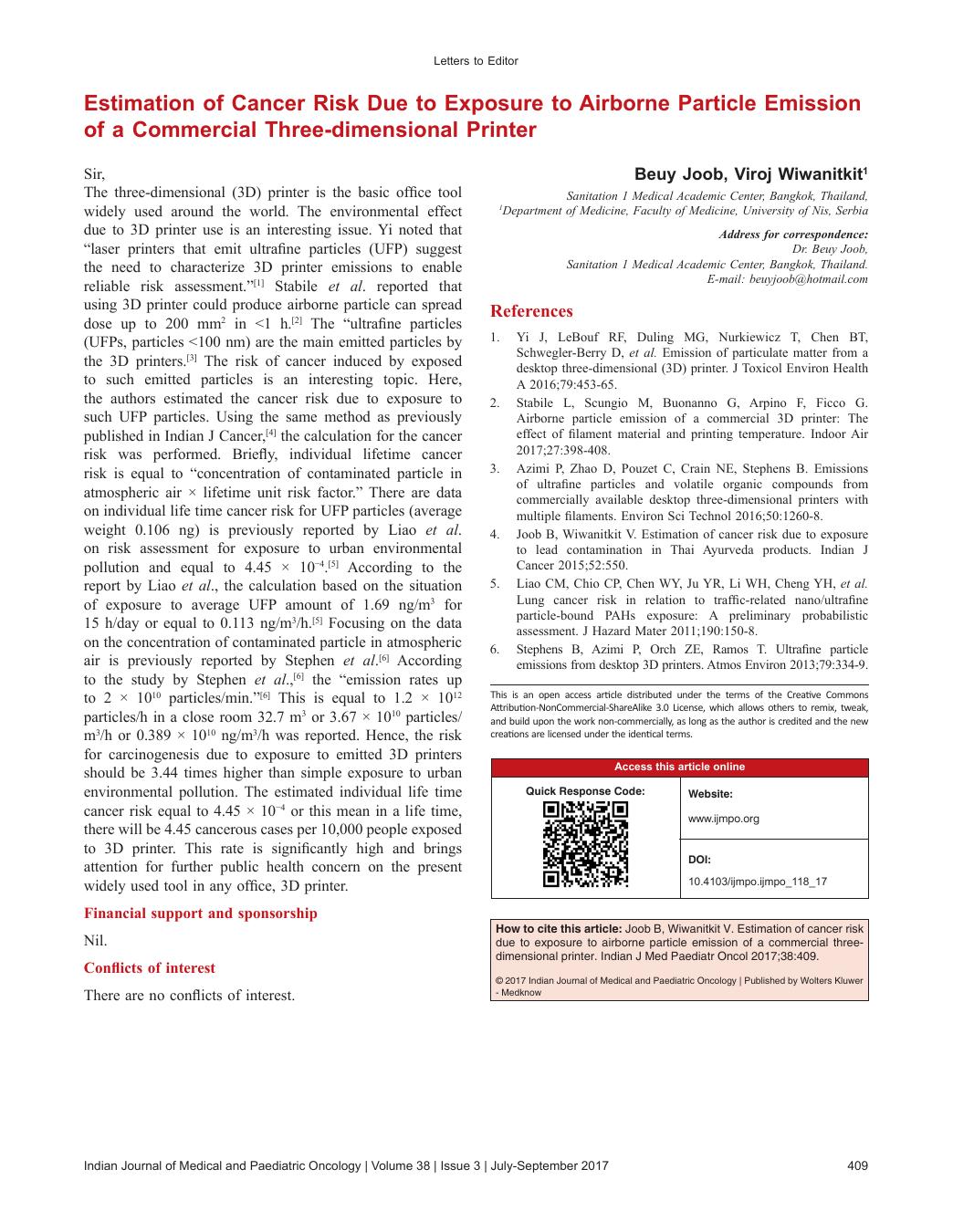Estimation of Cancer Risk Due to Exposure to Airborne Particle Emission of a Commercial Three?dimensional Printer
CC BY-NC-ND 4.0 · Indian J Med Paediatr Oncol 2017; 38(03): 409
DOI: DOI: 10.4103/ijmpo.ijmpo_118_17

|
Publication History
Article published online:
04 July 2021
© 2017. Indian Society of Medical and Paediatric Oncology. This is an open access article published by Thieme under the terms of the Creative Commons Attribution-NonDerivative-NonCommercial-License, permitting copying and reproduction so long as the original work is given appropriate credit. Contents may not be used for commercial purposes, or adapted, remixed, transformed or built upon. (https://creativecommons.org/licenses/by-nc-nd/4.0/.)
Thieme Medical and Scientific Publishers Pvt. Ltd.
A-12, 2nd Floor, Sector 2, Noida-201301 UP, India
Sir,
The three-dimensional (3D) printer is the basic office tool widely used around the world. The environmental effect due to 3D printer use is an interesting issue. Yi noted that “laser printers that emit ultrafine particles (UFP) suggest the need to characterize 3D printer emissions to enable reliable risk assessment.”[1] Stabile et al. reported that using 3D printer could produce airborne particle can spread dose up to 200 mm2 in <1 href="https://www.ncbi.nlm.nih.gov/pmc/articles/PMC5686999/#ref2" rid="ref2" class=" bibr popnode tag_hotlink tag_tooltip" id="__tag_649900270" role="button" aria-expanded="false" aria-haspopup="true" xss=removed>2] The “ultrafine particles (UFPs, particles <100 href="https://www.ncbi.nlm.nih.gov/pmc/articles/PMC5686999/#ref3" rid="ref3" class=" bibr popnode tag_hotlink tag_tooltip" id="__tag_649900266" role="button" aria-expanded="false" aria-haspopup="true" xss=removed>3] The risk of cancer induced by exposed to such emitted particles is an interesting topic. Here, the authors estimated the cancer risk due to exposure to such UFP particles. Using the same method as previously published in Indian J Cancer,[4] the calculation for the cancer risk was performed. Briefly, individual lifetime cancer risk is equal to “concentration of contaminated particle in atmospheric air × lifetime unit risk factor.” There are data on individual life time cancer risk for UFP particles (average weight 0.106 ng) is previously reported by Liao et al. on risk assessment for exposure to urban environmental pollution and equal to 4.45 × 10−4.[5] According to the report by Liao et al., the calculation based on the situation of exposure to average UFP amount of 1.69 ng/m3 for 15 h/day or equal to 0.113 ng/m3/h.[5] Focusing on the data on the concentration of contaminated particle in atmospheric air is previously reported by Stephen et al.[6] According to the study by Stephen et al.,[6] the “emission rates up to 2 × 1010 particles/min.”[6] This is equal to 1.2 × 1012 particles/h in a close room 32.7 m3 or 3.67 × 1010 particles/m3/h or 0.389 × 1010 ng/m3/h was reported. Hence, the risk for carcinogenesis due to exposure to emitted 3D printers should be 3.44 times higher than simple exposure to urban environmental pollution. The estimated individual life time cancer risk equal to 4.45 × 10−4 or this mean in a life time, there will be 4.45 cancerous cases per 10,000 people exposed to 3D printer. This rate is significantly high and brings attention for further public health concern on the present widely used tool in any office, 3D printer.
Financial support and sponsorshipNil.
Conflicts of interest
There are no conflicts of interest.
References
- Yi J, LeBouf RF, Duling MG, Nurkiewicz T, Chen BT, Schwegler-Berry D, et al. Emission of particulate matter from a desktop three-dimensional (3D) printer. J Toxicol Environ Health A 2016;79:453-65.
- Stabile L, Scungio M, Buonanno G, Arpino F, Ficco G. Airborne particle emission of a commercial 3D printer: The effect of filament material and printing temperature. Indoor Air 2017;27:398-408.
- Azimi P, Zhao D, Pouzet C, Crain NE, Stephens B. Emissions of ultrafine particles and volatile organic compounds from commercially available desktop three-dimensional printers with multiple filaments. Environ Sci Technol 2016;50:1260-8.
- Joob B, Wiwanitkit V. Estimation of cancer risk due to exposure to lead contamination in Thai Ayurveda products. Indian J Cancer 2015;52:550.
- Liao CM, Chio CP, Chen WY, Ju YR, Li WH, Cheng YH, et al. Lung cancer risk in relation to traffic-related nano/ultrafine particle-bound PAHs exposure: A preliminary probabilistic assessment. J Hazard Mater 2011;190:150-8.
- Stephens B, Azimi P, Orch ZE, Ramos T. Ultrafine particle emissions from desktop 3D printers. Atmos Environ 2013;79:334-9.
References
- Yi J, LeBouf RF, Duling MG, Nurkiewicz T, Chen BT, Schwegler-Berry D, et al. Emission of particulate matter from a desktop three-dimensional (3D) printer. J Toxicol Environ Health A 2016;79:453-65.
- Stabile L, Scungio M, Buonanno G, Arpino F, Ficco G. Airborne particle emission of a commercial 3D printer: The effect of filament material and printing temperature. Indoor Air 2017;27:398-408.
- Azimi P, Zhao D, Pouzet C, Crain NE, Stephens B. Emissions of ultrafine particles and volatile organic compounds from commercially available desktop three-dimensional printers with multiple filaments. Environ Sci Technol 2016;50:1260-8.
- Joob B, Wiwanitkit V. Estimation of cancer risk due to exposure to lead contamination in Thai Ayurveda products. Indian J Cancer 2015;52:550.
- Liao CM, Chio CP, Chen WY, Ju YR, Li WH, Cheng YH, et al. Lung cancer risk in relation to traffic-related nano/ultrafine particle-bound PAHs exposure: A preliminary probabilistic assessment. J Hazard Mater 2011;190:150-8.
- Stephens B, Azimi P, Orch ZE, Ramos T. Ultrafine particle emissions from desktop 3D printers. Atmos Environ 2013;79:334-9.


 PDF
PDF  Views
Views  Share
Share

